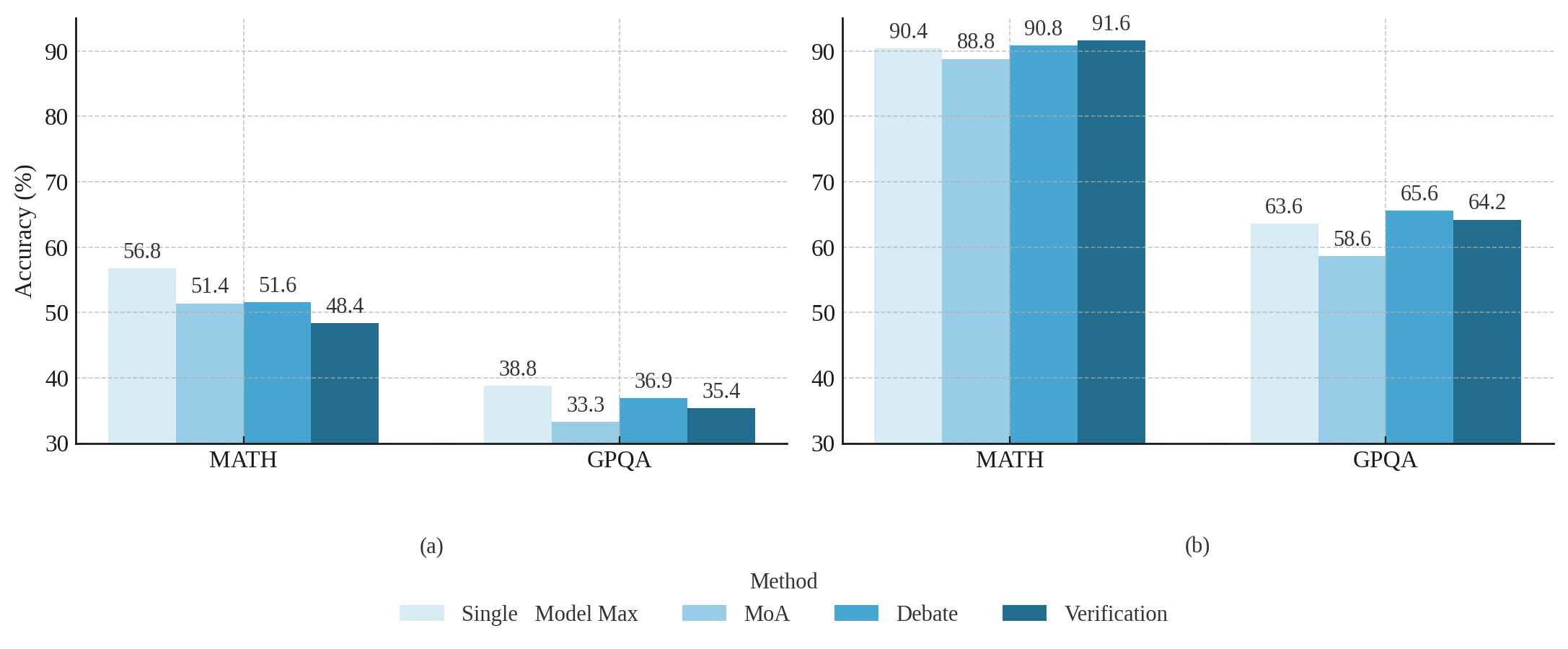Results
Takeaway 1: Orchestrating Small Language Models Outperforms a Single Large Model
A key question motivating our work is whether multiple small language models (SLMs), when effectively orchestrated, can match or exceed the performance of a single large language model (LLM). To investigate this, we compare our SLM-MUX system—built using just two SLMs—against Qwen 2.5 72B, a state-of-the-art large model with approximately 72 billion parameters. We evaluate both systems on three challenging reasoning benchmarks: MATH, GPQA, and GSM8K.
Results. As shown in Table 1, our SLM-MUX achieves remarkable results. Using only two carefully selected SLMs (Mistral Small 24B and Qwen2.5 7B), SLM-MUX significantly outperforms Qwen 2.5 72B on GPQA (49.9% vs. 44.9%, a gain of +5.0%) and GSM8K (93.7% vs. 90.4%, a gain of +3.3%). On MATH, SLM-MUX achieves 81.9% accuracy, nearly matching the 82.3% of Qwen 2.5 72B. These results demonstrate that properly orchestrated SLMs can rival or surpass models nearly 10× larger in parameter count.
Analysis. This performance advantage stems from two key factors. First, different SLMs exhibit complementary strengths: one model may excel at algebra while another performs better on geometry. By selecting outputs based on confidence scores, SLM-MUX leverages these complementary capabilities effectively. Second, our approach avoids the pitfalls of discussion-based methods (which harm SLM performance, as shown in Takeaway 2) by using a confidence-based selection mechanism that amplifies strengths rather than errors. This demonstrates that the path forward may involve orchestrating multiple smaller, specialized models rather than continuously scaling single models to ever-larger sizes.
| Benchmark | SLM-MUX (2 SLMs) |
Qwen 2.5 72B (Single LLM) |
Δ (Gain) |
|---|---|---|---|
| MATH | 81.9 ± 0.2% | 82.3 ± 0.5% | -0.4% |
| GPQA | 49.9 ± 1.8% | 44.9 ± 0.5% | +5.0% |
| GSM8K | 93.7 ± 0.2% | 90.4 ± 0.3% | +3.3% |
Takeaway 2: Discussion-Based Orchestration Harms SLM Performance
A natural question arises: if existing orchestration methods work well for frontier LLMs like GPT-4 and DeepSeek V3, shouldn't they also work for SLMs? To test this assumption, we conducted a systematic comparison of three prominent discussion-based approaches—LLM-Debate, Mixture-of-Agents, and Multi-Agent Verification. We ran these methods on two different model groups: (1) frontier LLMs (DeepSeek V3, Gemini 2.0 Flash, GPT-4o) and (2) SLMs (Llama 3.1 8B, Mistral 8×7B, Gemma 2 27B), using identical experimental settings and evaluation on MATH and GPQA benchmarks.
Results. The results reveal a striking divergence. While discussion-based methods successfully improve frontier LLM accuracy (up to 2% gains), the same methods consistently fail when applied to SLMs. Not only do they fail to surpass the best individual SLM in the group, but they can actually harm performance— reducing accuracy by up to 5.5% in some cases. This counterintuitive finding challenges the assumption that orchestration strategies transfer seamlessly across model scales.
Analysis. Why do these methods fail for SLMs? Our investigation reveals that SLMs exhibit a problematic form of "groupthink" during discussions. Instead of critically evaluating and correcting each other's mistakes, smaller models tend to reinforce incorrect reasoning patterns, amplifying errors rather than mitigating them. This suggests that the collaborative deliberation mechanisms that work for large models— which have stronger reasoning and self-correction abilities—break down when models lack sufficient capability to distinguish correct from incorrect reasoning. The appendix provides detailed empirical examples illustrating this phenomenon.

Takeaway 3: SLM-MUX Achieves SLM Orchestration Where Existing Methods Fail
Having demonstrated that discussion-based orchestration methods fail for SLMs (Takeaway 2), a natural question arises: can SLMs be orchestrated successfully at all? To answer this, we evaluate our proposed SLM-MUX against the same baselines that failed in Takeaway 2. We use the same experimental setup with three SLMs (Mistral 8×7B, LLaMA 3.1 8B, and Gemma 2 27B) and test on MATH, GPQA, and GSM8K benchmarks.
Results. Unlike existing orchestration methods that fail to outperform individual models when applied to SLMs, SLM-MUX consistently achieves substantial accuracy gains. Compared with other orchestration approaches, our method yields up to 13.4% improvement on MATH, up to 8.8% on GPQA, and up to 7.0% on GSM8K. These results demonstrate that SLM-MUX successfully orchestrates SLMs where existing methods fail, providing a clear architectural advantage over alternative orchestration approaches.
Analysis. The key to SLM-MUX's success lies in its confidence-based selection mechanism. Rather than forcing models to discuss and potentially amplify errors (as in discussion-based methods), SLM-MUX allows each model to independently generate multiple responses and estimates confidence by counting answer frequency. The system then selects outputs from the most confident model, effectively leveraging the complementary strengths of different SLMs. As shown in our output attribution analysis, SLM-MUX successfully draws upon diverse models to produce final answers, demonstrating that it effectively exploits the heterogeneity that exists across SLMs—something that discussion-based methods fail to achieve.
| Method | MATH Acc (%) |
GPQA Acc (%) |
GSM8K Acc (%) |
|---|---|---|---|
| Mixture-of-Agents | 51.4 ± 2.2 | 33.3 ± 3.4 | 81.6 ± 1.7 |
| LLM-Debate | 51.6 ± 2.2 | 36.8 ± 3.4 | 80.8 ± 1.8 |
| Multi-Agent Verification | 48.4 ± 2.2 | 35.3 ± 3.4 | 86.4 ± 1.5 |
| SLM-MUX (Ours) | 61.8 ± 1.2 | 42.1 ± 0.3 | 87.8 ± 0.6 |
| Single-Best | 56.8 ± 2.2 | 38.9 ± 3.5 | 84.2 ± 1.6 |
| Single-Best-SC | 58.0 ± 2.2 | 42.4 ± 3.5 | 86.8 ± 1.5 |


